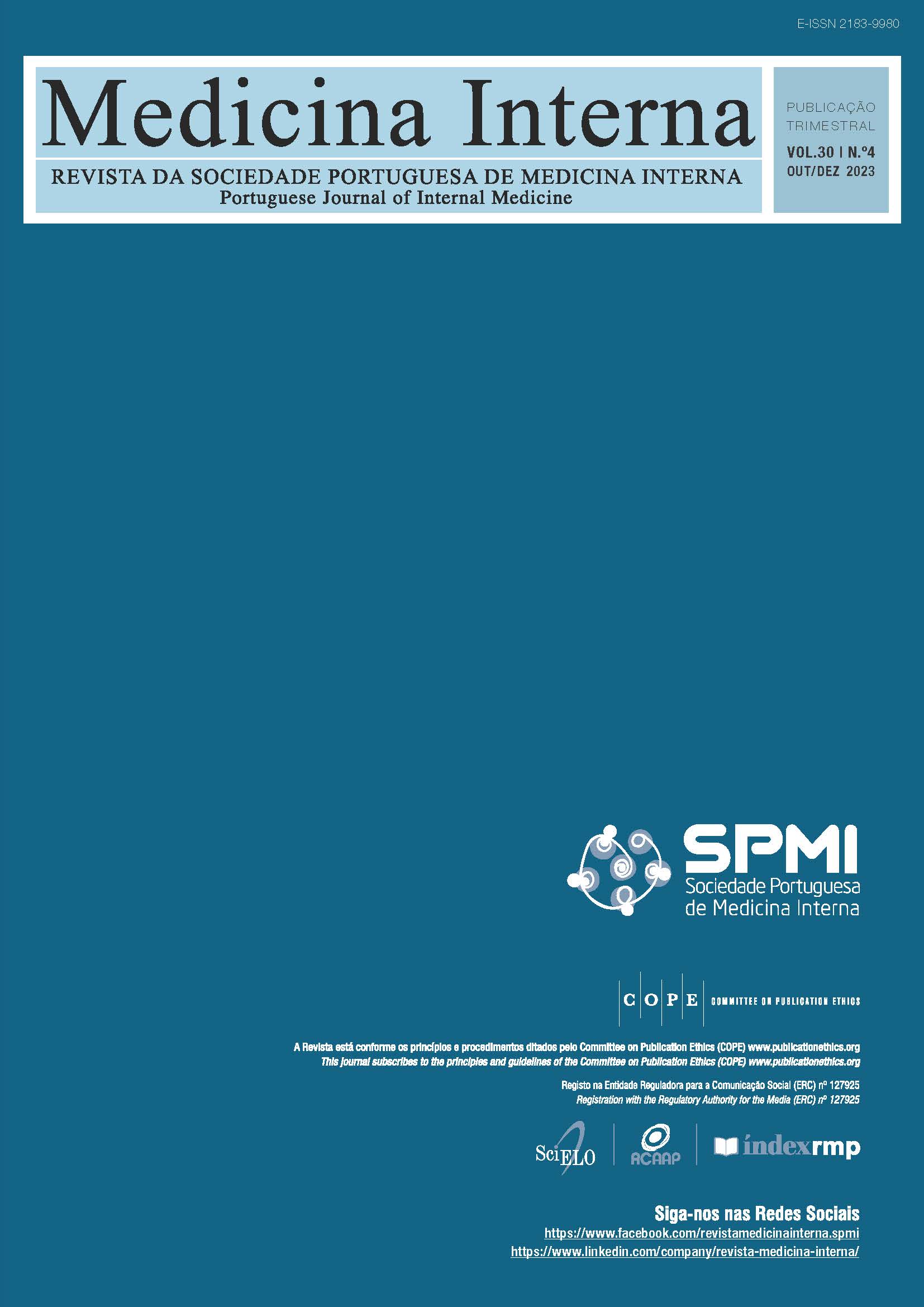Hipocoagulation in Patients with Atrial Fibrillation and Admitted for Hemorrhagic Stroke
DOI:
https://doi.org/10.24950/rspmi.1602Keywords:
Anticoagulants, Atrial Fibrillation, Hemorrhagic StrokeAbstract
Introduction: The stroke prevention strategy in patients
with intracerebral hemorrhage (ICH) and atrial fibrillation (AF) is a clinical dilemma. The aim of this study was to evaluate the management of anticoagulation therapy in patients with AF and admitted with ICH.
Methods: We performed a descriptive analysis of patients
admitted for ICH from 2009 to 2021. Data collection was carried out by consulting the processes and analyzing demographic, clinical and imaging data, and prior and post-discharge therapy. A comparative analysis of outcomes of anticoagulant therapy was performed between direct oral anticoagulants (DOACs) and vitamin K antagonists (VKAs).
Results: A total of 28 patients (22 male patients; median
age 75 years) were included in the study, of which 19 were
previously on anticoagulation therapy. Only eight (re)started anticoagulation after discharge. There were 19 deaths, of which 17 were in the group without post-discharge anticoagulation; of those, five occurred in the first month after ICH.
Conclusion: Most patients did not (re)initiate anticoagulation after ICH, despite being a high-risk group for new cerebrovascular events, which makes the discussion on this topic even more relevant. There was a change in the prescription pattern from VKAs to DOACs, comparing the two periods analyzed.
Downloads
References
Klijn CJM, Paciaroni M, Berge E, Korompoki E, Kõrv J, Lal A, et al. Antithrombotic treatment for secondary prevention of stroke and other thromboembolic events in patients with stroke or transient ischemic attack and non-valvular atrial fibrillation: A European Stroke Organisation guideline. Eur Stroke J. 2019;4:198-223. doi: 10.1177/2396987319841187
Sargento-Freitas J, Silva F, Koehler S, Isidoro L, Mendonça N, Machado C, et al. Fibrilhação Auricular na Doença Cerebrovascular: A Perspectiva Neurológica Nacional. Acta Med Port. 2013;26:86-92.
Arnett DK, Blumenthal RS, Albert MA, Buroker AB, Goldberger ZD, Hahn EJ, et al. 2019 ACC/AHA Guideline on the Primary Prevention of Cardiovascular Disease: Executive Summary: A Report of the American College of Cardiology/American Heart Association Task Force on Clinical Practice Guidelines. J Am Coll Cardiol. 2019;74:1376-414. doi: 10.1016/j.jacc.2019.03.009
Greenberg SM, Ziai WC, Cordonnier C, Dowlatshahi D, Francis B, Goldstein JN, et al. 2022 Guideline for the Management of Patients With Spontaneous Intracerebral Hemorrhage: A Guideline From the American Heart Association/American Stroke Association. Stroke. 2022;53:e282-e361. doi: 10.1161/STR.0000000000000407.
INFARMED IP, Correia A, Costa I, Caldeira S. Anticoagulantes Orais - Utilização e Despesa. Lisboa: Infarmed; 2019.
Nielsen PB, Larsen TB, Gorst-Rasmussen A, Skjøth F, Rasmussen LH, LipGY. Intracranial haemorrhage and subsequent ischemic stroke in patients with atrial fibrillation: A nationwide cohort study. Chest. 2015;147:1651-8.
Nielsen PB, Melgaard L, Overvad TF, Jensen M, Larsen TB, Lip GY, et al. Risk of Cerebrovascular Events in Intracerebral Hemorrhage Survivors With Atrial Fibrillation: A Nationwide Cohort Study. Stroke. 2022;53:2559-68. doi: 10.1161/STROKEAHA.121.038331.
Zhao B, Jia WB, Zhang LY, Wang TZ. 1/2SH: A Simple, Accurate, and Reliable Method of Calculating the Hematoma Volume of Spontaneous Intracerebral Hemorrhage. Stroke. 2020;51:193-201. doi: 10.1161/STROKEAHA.119.026951
Ruff CT, Giugliano RP, Braunwald E, Hoffman EB, Deenadayalu N, Ezekowitz MD, et al. Comparison of the efficacy and safety of new oral anticoagulants with warfarin in patients with atrial fibrillation: a meta-analysis of randomised trials. Lancet. 2014;383:955-62. doi: 10.1016/S0140-6736(13)62343-0.
Downloads
Published
How to Cite
Issue
Section
Categories
License
Copyright (c) 2023 Internal Medicine

This work is licensed under a Creative Commons Attribution 4.0 International License.
Copyright (c) 2023 Medicina Interna






